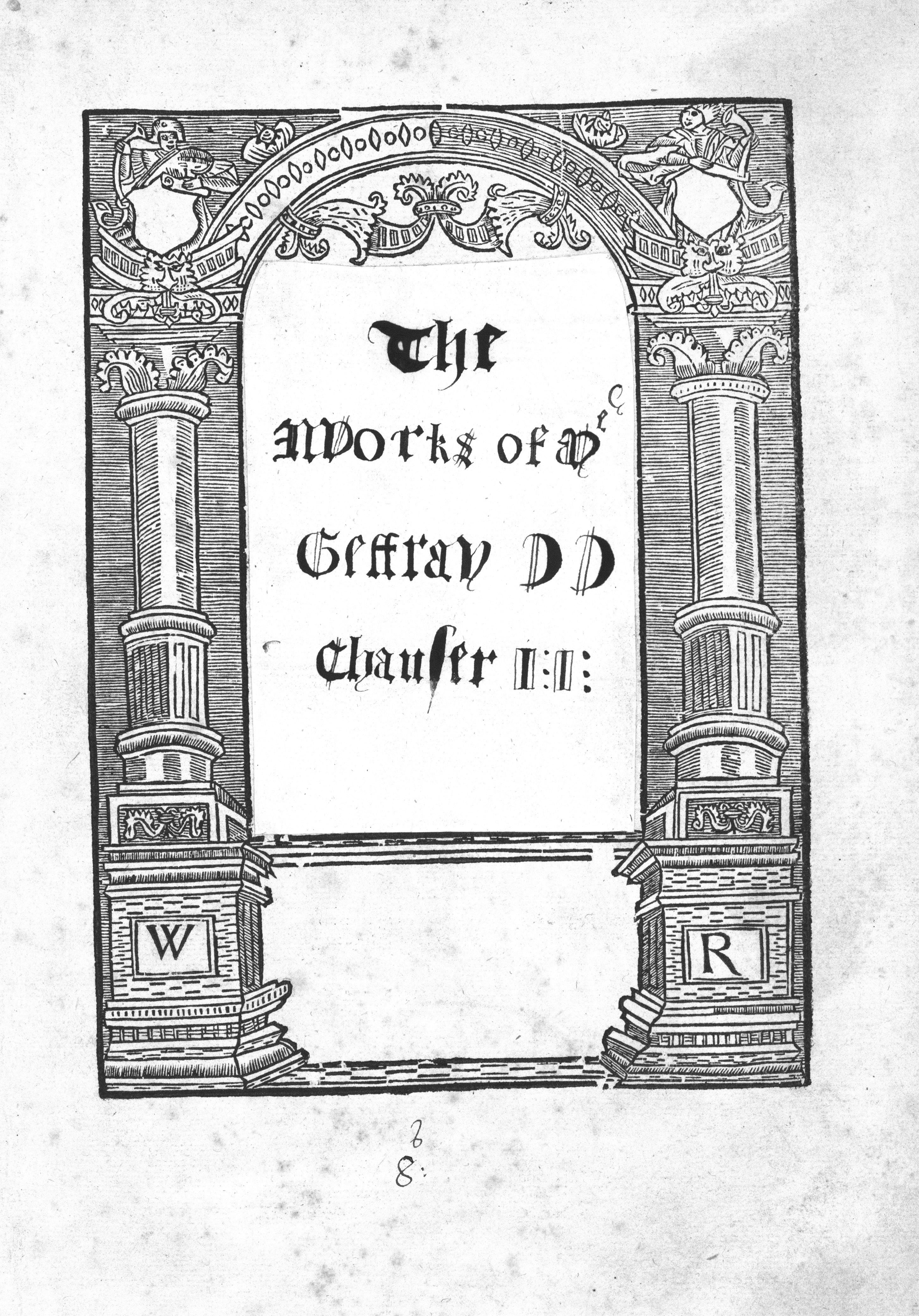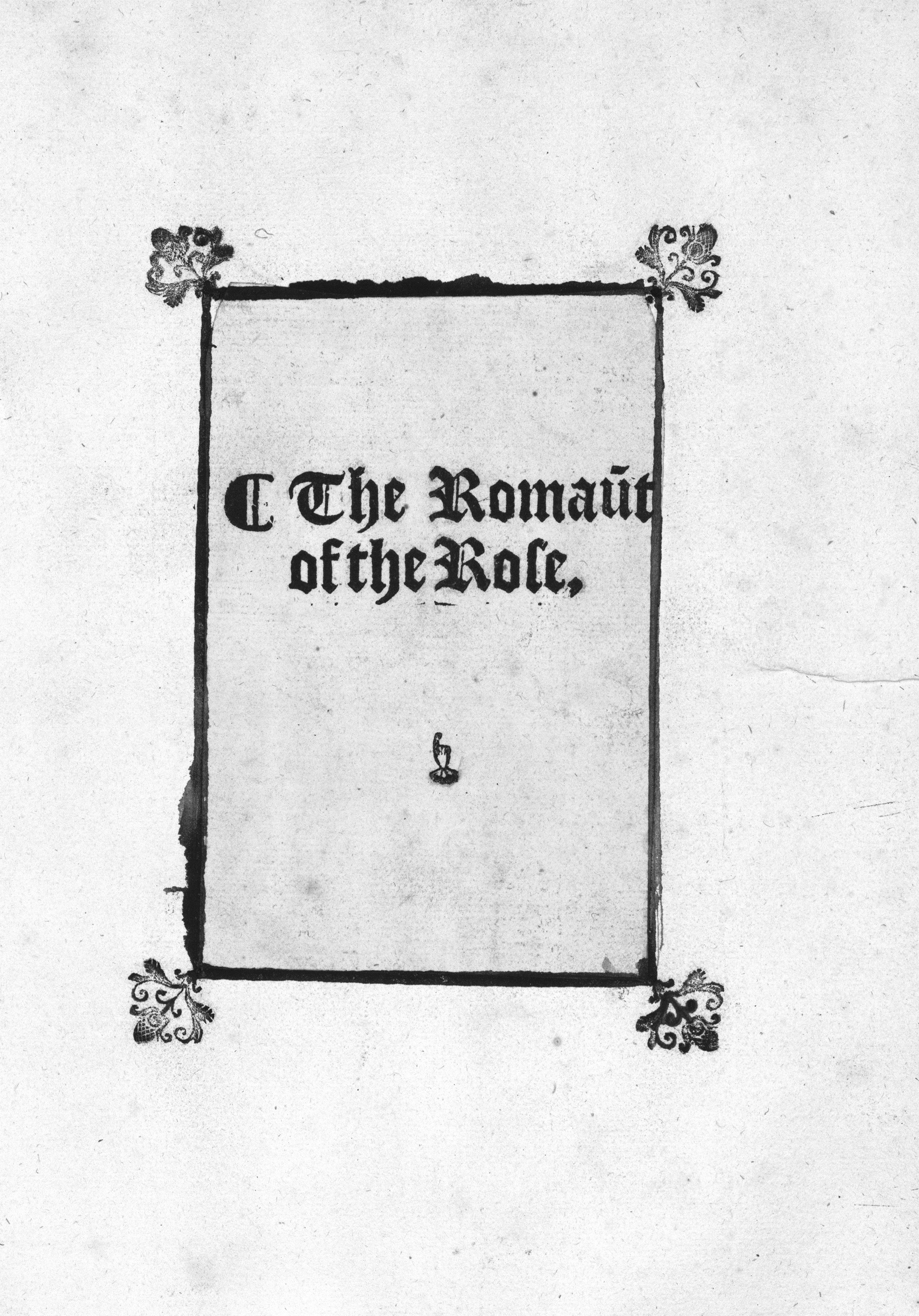|
READERS' MEMORIALS IN EARLY EDITIONS OF CHAUCER
| ||
Customized Title Pages
Scholars have noted how the architectural borders used for early editions of Chaucer's Works bear a visual resemblance to a physical memorial. The title page of Martin's copy of the 1542 edition, crafted by Reverend Mr. Nathaniel Coddington (figure 3), is consistent with this pattern. He carefully cuts and pastes a border identified by R. B. McKerrow and F. S. Ferguson as being in use from 1551 through 1622 (no. 76).29 For Coddington, the most important information clearly is the identity of the author: "CH|AVC|ER" fills the entirety of the space available for a title, though information about the imprint can be found in manuscript at the bottom of the page: "Printed in 1542. by John Reyne at the signe of the St George | in Pauls Churchyarde." Another book owner, this time of Cambridge University Library Syn.5.53.1, a copy of the 1532 edition, combines a carefully trimmed border (McKerrow and Ferguson no. 19) with a title ascribing the book to Caxton's Westminster press (figure 9). One can hazard a fairly good guess at the owner's motivation for doing so since the cachet and resale value of a Caxton would be higher than that of the book with its original 1532 title page.
A provenance note by Samuel Sandars addresses the state of the title page:
A different principle seems to be at work in a copy of the 1542 edition at the Harry Ransom Center, which makes use of a printed border (McKerrow and Ferguson no. 20). A slip written by hand in a manner emulating the black-letter typeface is pasted over the original printed title. The title page for the Romaunt of the Rose, meanwhile, keeps the printed text of the title, accented with fleurons, but discards the rest of the original design (figure 10). Further examination of the book reveals that the owner covers existing marginalia with slips of blank paper pasted in. Since title pages tend to attract ownership inscriptions and pen trials, this particular owner may have decided that the cleanest solution would be to start anew in the case of the Works title page, and to paste the title from the Romaunt of the Rose on a clean page.30


FIGURE 9. Title page advertising Thynne's 1532 edition as a Caxton. Reproduced by kind permission of the Syndics of Cambridge University Library (Syn. 5.53.1).



FIGURE 10. Customized title pages in a copy of Thynne's 1542 edition. Harry Ransom Center, The University of Texas at Austin (PR 1850 1542b copy 4).

These self-fashioned title pages make use of printed elements, but an artistic owner of Thynne's ca. 1550 edition at Wesleyan University Library supplied his or her copy with a title page by drawing a facsimile of the Speght title page (figure 11). Was the 1598 title page used as a model damaged as well? An irregular patch of text is missing, but with penciled ruling to connect words that originally appeared on the same line, on either side of the break. The same or another reader completes partially formed words in pencil and supplies omitted text. It also serves to correct the artist's textual errors, e.g., Figture should read Portraiture in item one; AutPrs should read Authors in item five; and London is instead Londini on the Speght title page. Overall, however, the visual aspect of the page is striking in its rendering of the architectural borders. Capturing the visual grandeur of the page demonstrates the foremost importance to this artist of design rather than words, which are dominant in the other examples. Owners of the books at the British Library (figure 3), the Cambridge University Library (figure 9), the Harry Ransom Center (figure 10), and the Wesleyan University Library (figure 11) thus show a variety of inventive strategies for supplying a title page that was wanting or restoring an imperfect leaf to serve as a more suitable entryway for subsequent readers of the text.
The architectural borders of the title page sometimes inspired book owners to affix their own armorial bookplate at the foot of the title page. In a copy at the Cambridge University Library, the bookplate of the Peterborough Cathedral becomes an extension of the architectural border, intentionally integrating it with the printed page (figure 12). Another example of this approach appears in a copy of Thynne's ca. 1550 edition at Trinity College Dublin (V dd 16). The armorial bookplate of Theophilus Butler, esq. which features his motto, "Liberté tout entiere," does indeed take some liberties with the title page design with the addition of his engraved plate. These two examples are making additions not in order to supply wanting material but rather to augment the title page with an ornate symbol of the owner's identity near the marquee billing of Chaucer as author.
|
READERS' MEMORIALS IN EARLY EDITIONS OF CHAUCER
| ||